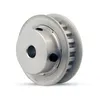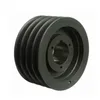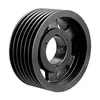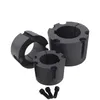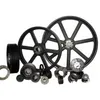A Pulley is a simple machine consisting of a wheel on an axle or shaft, designed to support movement and change of direction of a taut cable or belt, or transfer of power between the shaft and cable or belt. Pulley systems are widely used in various applications, from industrial machinery to everyday tools, due to their ability to provide mechanical advantage, reduce effort, and enable lifting or moving heavy loads with ease. Understanding the components, types, and specifications of pulleys is essential for selecting the right product for your needs.
Every pulley system comprises several critical parts that work together to function efficiently. Here's a list of the main components:
Pulleys come in various types, each suited for specific uses. Below is a table summarizing the common types:
| Type | Description | Common Applications |
|---|---|---|
| Fixed Pulley | A pulley attached to a stationary structure, changing the direction of force without providing mechanical advantage. | Flagpoles, lifting systems where direction change is needed. |
| Movable Pulley | A pulley attached to the load, moving with it, providing mechanical advantage by reducing the effort required. | Construction cranes, weightlifting equipment. |
| Compound Pulley | A system combining fixed and movable pulleys to increase mechanical advantage significantly. | Elevators, heavy machinery for lifting large loads. |
| Belt Drive Pulley | Used with belts to transfer power between shafts in machinery. | Conveyor systems, automotive engines. |
| Rope Pulley | Designed for use with ropes or cables, often in rigging and hoisting applications. | Sailing, theater rigging, rescue operations. |
When selecting a pulley, it's crucial to consider various parameters to ensure compatibility and performance. Here is a comprehensive table of key specifications:
| Parameter | Description | Typical Values/Range |
|---|---|---|
| Diameter | The size of the wheel, affecting speed and mechanical advantage. | 50 mm to 500 mm |
| Material | The construction material, influencing strength, weight, and corrosion resistance. | Steel, aluminum, nylon, plastic |
| Load Capacity | The maximum weight the pulley can handle safely. | 100 kg to 10,000 kg |
| Groove Type | The shape of the groove, compatible with specific belts or ropes. | V-groove, U-groove, flat groove |
| Bearing Type | The type of bearing used for rotation, affecting smoothness and lifespan. | Ball bearing, roller bearing, sleeve bearing |
| Weight | The mass of the pulley, important for portable applications. | 0.1 kg to 20 kg |
| Operating Temperature | The temperature range within which the pulley functions effectively. | -40°C to 120°C |
| Corrosion Resistance | Resistance to rust and degradation, especially in outdoor or humid environments. | Stainless steel, coated materials |
Pulleys are versatile and used across numerous industries. Here's a list of common applications:
What is the mechanical advantage of a pulley system?
The mechanical advantage refers to the factor by which a pulley system multiplies the force applied. For example, a single movable pulley provides a mechanical advantage of 2, meaning it halves the effort needed to lift a load. Compound systems can achieve higher advantages, such as 4 or more, depending on the number of pulleys used.
How do I choose the right pulley material?
Select the material based on your application's requirements. Steel pulleys offer high strength and durability for heavy loads, aluminum is lightweight and corrosion-resistant for maritime use, nylon or plastic pulleys are cost-effective and suitable for light-duty applications where noise reduction is important.
Can pulleys be used in high-temperature environments?
Yes, but you must choose pulleys made from materials that can withstand high temperatures, such as heat-treated steel or specialized alloys. Always check the operating temperature range specified by the manufacturer to ensure safety and performance.
What maintenance is required for pulleys?
Regular maintenance includes lubricating the bearing to reduce friction and wear, inspecting for cracks or deformities, and ensuring the groove is clean and free from debris. For industrial use, follow a scheduled maintenance plan based on usage intensity.
How does pulley diameter affect performance?
Larger diameters generally allow for higher belt speeds and reduced wear on the belt, but they may require more space and increase weight. Smaller diameters are compact but might lead to faster belt degradation if not matched properly with the application.
Are there pulleys designed for specific belts?
Absolutely. Pulleys are often designed to match specific belt types, such as V-belts, timing belts, or flat belts. The groove shape and size must correspond to the belt profile to prevent slippage and ensure efficient power transmission.
What safety precautions should I take when using pulleys?
Always ensure the load does not exceed the pulley's rated capacity, use appropriate personal protective equipment, and secure the pulley system firmly to avoid accidents. Regularly inspect for signs of wear or damage, and replace components as needed.
Can I use multiple pulleys together?
Yes, combining multiple pulleys in a system, such as a block and tackle, can significantly increase mechanical advantage. This is common in lifting heavy objects where reduced effort is crucial. Ensure all pulleys are compatible and properly aligned.
What is the difference between a pulley and a sheave?
The terms are often used interchangeably, but technically, a sheave refers specifically to the wheel part of a pulley system, especially in contexts like rigging or machinery. A pulley includes the entire assembly, such as the wheel, axle, and frame.
How do I calculate the mechanical advantage of a compound pulley system?
To calculate the mechanical advantage, count the number of rope segments supporting the load. For instance, if there are four segments, the mechanical advantage is approximately 4, meaning the effort required is one-fourth of the load weight. Always account for friction losses in real-world applications.
